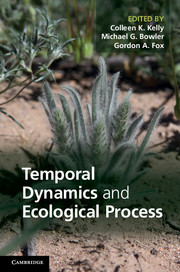Book contents
- Frontmatter
- Contents
- List of Contributors
- 1 Introduction
- Part I Observing temporal processes in nature
- Part II Application to specific questions
- 9 Evolution of synchronised and intermittent reproduction (masting) of trees: key role of regeneration dynamics
- 10 Spatiotemporal variation can promote coexistence more strongly than temporal variation
- 11 Roles of pollinator attraction and environmental fluctuation in inducing flowering synchrony
- 12 Temporal dynamics and the spread of insect resistance transgenes
- 13 Concluding remarks
- Index
- References
10 - Spatiotemporal variation can promote coexistence more strongly than temporal variation
Published online by Cambridge University Press: 18 December 2013
- Frontmatter
- Contents
- List of Contributors
- 1 Introduction
- Part I Observing temporal processes in nature
- Part II Application to specific questions
- 9 Evolution of synchronised and intermittent reproduction (masting) of trees: key role of regeneration dynamics
- 10 Spatiotemporal variation can promote coexistence more strongly than temporal variation
- 11 Roles of pollinator attraction and environmental fluctuation in inducing flowering synchrony
- 12 Temporal dynamics and the spread of insect resistance transgenes
- 13 Concluding remarks
- Index
- References
Summary
Introduction
Spatiotemporal variation in environmental conditions is ubiquitous and can help or hinder species coexistence. It is not always clear, however, when we should expect environmental variation to promote coexistence nor what forms of variation can do so most effectively. This chapter seeks to answer two questions. First, when does spatiotemporal variation most promote coexistence and why? It turns out that spatiotemporal variation promotes coexistence most effectively via spatial mechanisms and this leads us to the second question: is spatiotemporal variation more or less able to promote coexistence than purely temporal variation and why? For those who are interested, this chapter also gathers together mathematical calculations which have been scattered throughout the appendices of several papers (Snyder 2006, 2007, 2008). Here I state in one place how to get from environmental autocorrelation functions to spatiotemporal population distributions to a calculation of how much variation increases or decreases an invader’s long-run growth rate.
I explore these issues using a model of competing annual plants that is presented in the next section. The model discussion is followed by an overview of the mathematical methods, which should be accessible to everyone, and a more detailed presentation of the mathematics, for those who may wish to use these methods themselves. Next I present the results of a numerical experiment in which I systematically vary each species’ dormancy, seed dispersal distance and competition distances, and determine how much environmental variation promotes coexistence for each combination of traits. I find that regardless of the scale of spatial or temporal autocorrelation in environmental conditions, spatiotemporal variation most promotes coexistence when species have traits that encourage population aggregation and species segregation. While low dormancy and short-range between-species competition contribute to these tendencies, short-range seed dispersal is essential. I also find that spatiotemporal variation has a much higher capacity to promote coexistence than temporal variation does, and I discuss reasons for this. The chapter ends with a discussion section.
Information
- Type
- Chapter
- Information
- Temporal Dynamics and Ecological Process , pp. 224 - 250Publisher: Cambridge University PressPrint publication year: 2014
